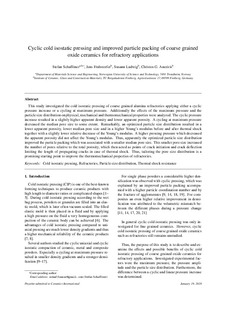| dc.contributor.author | Schafföner, Stefan | |
| dc.contributor.author | Fruhstorfer, Jens | |
| dc.contributor.author | Ludwig, Susann | |
| dc.contributor.author | Aneziris, Christos G | |
| dc.date.accessioned | 2019-08-13T10:35:37Z | |
| dc.date.available | 2019-08-13T10:35:37Z | |
| dc.date.created | 2018-12-04T21:36:35Z | |
| dc.date.issued | 2018 | |
| dc.identifier.citation | Ceramics International. 2018, 44 (8), 9027-9036. | nb_NO |
| dc.identifier.issn | 0272-8842 | |
| dc.identifier.uri | http://hdl.handle.net/11250/2608096 | |
| dc.description.abstract | This study investigated the cold isostatic pressing of coarse grained alumina refractories applying either a cyclic pressure increase or a cycling at maximum pressure. Additionally the effects of the maximum pressure and the particle size distribution on physical, mechanical and thermomechanical properties were analyzed. The cyclic pressure increase resulted in a slightly higher apparent density and lower apparent porosity. A cycling at maximum pressure decreased the median pore size to some extent. Remarkably, an optimized particle size distribution resulted in a lower apparent porosity, lower median pore size and in a higher Young's modulus before and after thermal shock together with a slightly lower relative decrease of the Young's modulus. A higher pressing pressure which decreased the apparent porosity did not affect the Young's modulus. Thus, apparently the optimized particle size distribution improved the particle packing which was associated with a smaller median pore size. This smaller pore size increased the number of pores relative to the total porosity, which then acted as points of crack initiation and crack deflection limiting the length of propagating cracks in case of thermal shock. Thus, tailoring the pore size distribution is a promising starting point to improve the thermomechanical properties of refractories. | nb_NO |
| dc.language.iso | eng | nb_NO |
| dc.publisher | Elsevier | nb_NO |
| dc.rights | Attribution-NonCommercial-NoDerivatives 4.0 Internasjonal | * |
| dc.rights.uri | http://creativecommons.org/licenses/by-nc-nd/4.0/deed.no | * |
| dc.title | Cyclic cold isostatic pressing and improved particle packing of coarse grained oxide ceramics for refractory applications | nb_NO |
| dc.type | Journal article | nb_NO |
| dc.type | Peer reviewed | nb_NO |
| dc.description.version | acceptedVersion | nb_NO |
| dc.source.pagenumber | 9027-9036 | nb_NO |
| dc.source.volume | 44 | nb_NO |
| dc.source.journal | Ceramics International | nb_NO |
| dc.source.issue | 8 | nb_NO |
| dc.identifier.doi | 10.1016/j.ceramint.2018.02.106 | |
| dc.identifier.cristin | 1639207 | |
| dc.description.localcode | © 2018. This is the authors’ accepted and refereed manuscript to the article. Locked until 13.2.2020 due to copyright restrictions. This manuscript version is made available under the CC-BY-NC-ND 4.0 license http://creativecommons.org/licenses/by-nc-nd/4.0/ | nb_NO |
| cristin.unitcode | 194,66,35,0 | |
| cristin.unitname | Institutt for materialteknologi | |
| cristin.ispublished | true | |
| cristin.fulltext | preprint | |
| cristin.fulltext | postprint | |
| cristin.qualitycode | 1 | |

